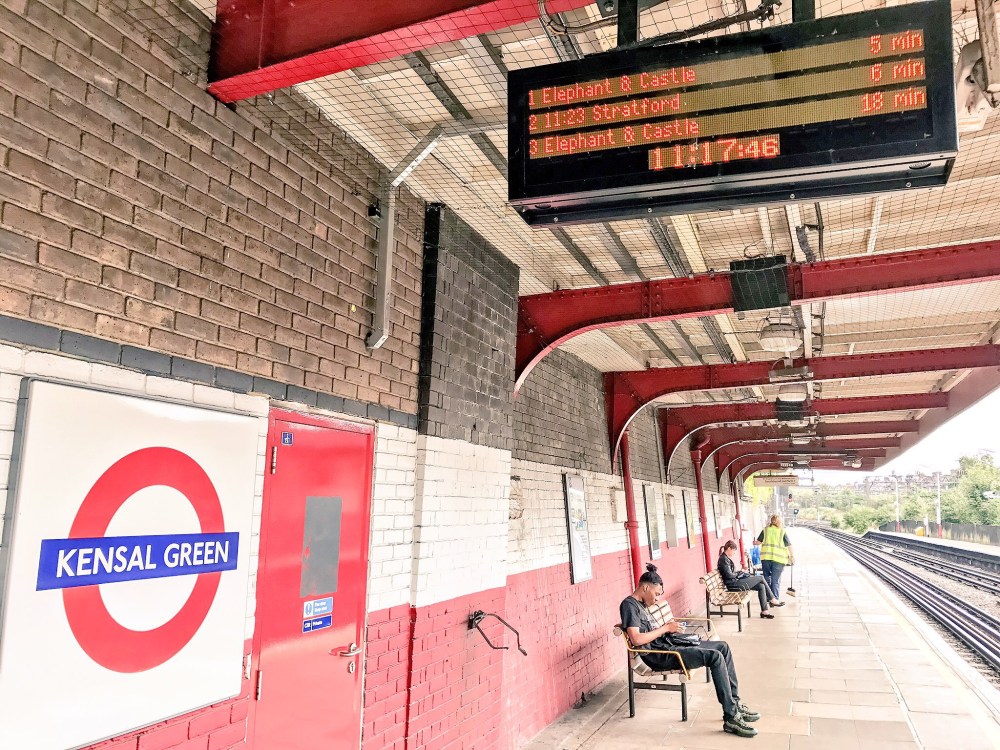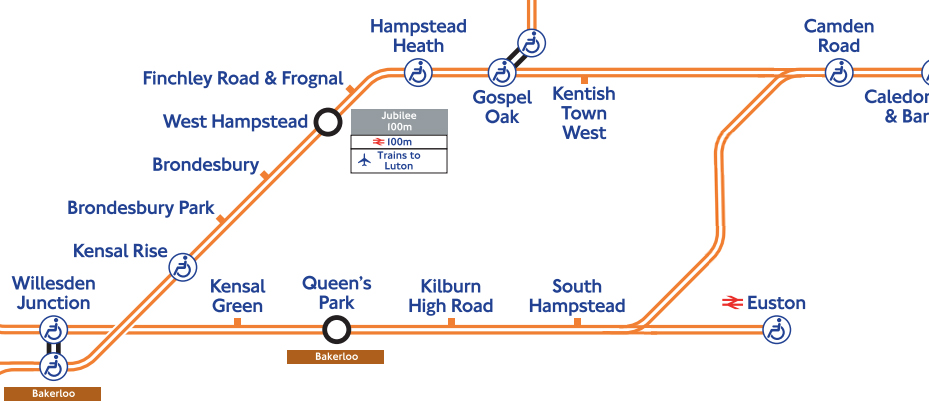
For the last couple of weekends one of my favourite transport-works related diversions took place once again. Overground trains ran a route that appears on no official TfL maps, traversing North London by straddling two of the orange lines that most wouldn’t think linked. Yep, I’m talking about the lesser-spotted Willesden Junction to Stratford service, going via Queen’s Park and South Hampstead.
You what?
So the North London line bit of the Overground usually runs from Willesden Junction to Stratford via Hampstead Heath and Gospel Oak, as can be seen on the TfL route diagram.

However, on the odd occasion that engineering works are necessary on the Willesden Junction-Hampstead Heath-Camden Road section, London Overground run a secret (well, not really – Journey Planner knows about it) alternate route. This runs along the Watford – Euston branch from Willesden Junction to South Hampstead, then veers off the published maps, hopping off the tracks and running through industrial wasteland until it reaches Camden Road and rejoins the usual route. My slightly crude Photoshop line-map rendition demonstrates this below…

But how?
Well obviously the trains don’t forgo the tracks and bump along abandoned brownfield sites to make this less common journey. As is so often the case, the line diagrams are deceptive, and actually Camden Road station and the lines out of Euston are very close indeed, with a track connection having existed since 1851.

What’s the story?
The services on the London Overground today bear little resemblance to how many parts of the railway which make up the current system were historically used. These railways were built over many years from the 1850s, often by separate companies offering journeys that are today long forgotten.
Over time these different bits have merged, run down, closed down, re-configured and reopened. Stations have been built, moved, demolished, rebuilt. Stretches of track have been commandeered by other railways with services and trains sent in different directions.
A lot can be read online about the history of how it all came together, and so I’ll just try and stick to the relevant bits here.
Getting back to our little link through Primrose Hill, this section of track was fairly recently used for regular scheduled passenger services. Prior to 1986, peak-hours trains ran from Watford, along the current route most of the way to Euston, but then cutting through Primrose Hill, across the North London line and then down via Dalston Junction into Broad Street station.
For those that don’t know, Broad Street was a vast terminus right next door to Liverpool Street. Once heavily used, decline had set in during the 60s and 70s and in the mid-80s it closed for good and was demolished. The viaduct from Dalston Junction was also decommissioned at that time, and it wasn’t until 2010 that it found new life as part of the East London line section of the Overground – another example of how the infrastructure has been repurposed over time.
In the years following, the Watford services staggered on using an alternate route via Hackney Downs into Liverpool Street, but use of the trains had fallen to such an extent that the route was closed down altogether in 1992.
Anything else?
As if all that wasn’t interesting enough, this little-used Primrose Hill stretch is also home to a ghost station. On the corner of Regent’s Park Road bridge that spans the mainline from Euston, there’s a building that was once the entrance to Primrose Hill station. It opened in 1851, and was also known at various times as “Chalk Farm” and “Hampstead Road”. Closure came when scheduled services into Liverpool Street ended in the 90s, but the platform level buildings weren’t demolished until 2008.
The photo with the Roundhouse in the background shows a glimpse of the remaining platforms, very much overgrown and returned to the wild. Calls are sometimes made to reopen this station, but it would depend on Overground being able to set one or more new routes which would presumably cause difficulty with running the overcrowded services that currently exist.
So why is this your favourite diversion?
Very simply, I live in Kensal Green so getting a new service from the local station, albeit for one or two days at a time only, is pretty exciting. Especially when I want to go and see friends in East London, no need to schlep all the way up to Kensal Rise!
The message then is to keep your eyes open when there are weekend engineering works, you never know where your train might end up taking you!
Edit: 2.10.2016
I took the this special service today on my way to Highbury & Islington and managed to get a bit of footage as we passed through Primrose Hill. I’m not going to lie, there isn’t THAT much to see. You can view it on YouTube HERE.
I also enjoyed this attempt at updated the line information at Highbury & Islington station!






Fascinating stuff; shows how things have changed over the years and what the demand is now compared to what it was and what they thought it was going to be, it’s interesting to think about how that demand has been driven and how it’s been responded to.
LikeLiked by 1 person
Some years ago, or a while Anglia Railways (?) were running trains across London using a section of the NLR, doing something like Guildford to Chelmsford, my memory fails me on the details, but gave me a route Brentford to West Hampstead, which would be useful today…
Anyway – engineering work in the east one day gave me a train from Brentford round into Liverpool St – nicely circuitous 😉
LikeLike
I was sat on this diversion (unknowingly and extremely hungover) once, and thought I’d broken my brain when we glided past the old TV-am building complete with eggcup balustrades.
LikeLiked by 1 person
Ha! I’ve been on it going East to West before and seen people become utterly confused when the stations that came next no longer corresponded to the ones on the line map!
LikeLike